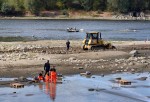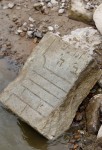 Another summer of severe drought has dropped the water level of Poland’s Vistula river to just 16 inches, creating what is basically a vast archaeological buffet table through the middle of Warsaw. Three years ago when the Vistula was 24 inches deep it was already the lowest level since recording began in 1789, and archaeologists were able to recover a trove of marble and alabaster architectural features looted from the city’s Royal Castle by Swedish invaders in 1656. More pieces of the Royal Castle are being recovered now, but that’s not all.
Another summer of severe drought has dropped the water level of Poland’s Vistula river to just 16 inches, creating what is basically a vast archaeological buffet table through the middle of Warsaw. Three years ago when the Vistula was 24 inches deep it was already the lowest level since recording began in 1789, and archaeologists were able to recover a trove of marble and alabaster architectural features looted from the city’s Royal Castle by Swedish invaders in 1656. More pieces of the Royal Castle are being recovered now, but that’s not all.
Other items to emerge from the Vistula this summer include pieces of bridges and boats, as well as ceramic objects dating as far back as 700 to 400 BC.
They include obelisks and bases of columns that likely came from Warsaw’s Kazimierz Palace, which was built in the 17th century and is today a Warsaw University building.
 Last week archaeologists were able to recover pieces of two destroyed bridges. One of them is the Poninski Bridge, a wooden pontoon bridge built in 1775 that was supported by a line of 43 boats spanning the river. It was burned on November 4th, 1794, on the orders of Thomas Wawrzecki, leader of the Kosciuszko Uprising against Russian occupation. (Its leader and namesake, American Revolutionary War hero Thaddeus Kosciuszko, had been captured and imprisoned by the Russians a month earlier.) The Russians had just broken the Polish lines on the outskirts of Warsaw and massacred 20,000 civilians in the suburb of Praga. Wawrzecki hoped that disabling the bridge would keep them reaching the left bank of the Vistula and taking Warsaw proper.
Last week archaeologists were able to recover pieces of two destroyed bridges. One of them is the Poninski Bridge, a wooden pontoon bridge built in 1775 that was supported by a line of 43 boats spanning the river. It was burned on November 4th, 1794, on the orders of Thomas Wawrzecki, leader of the Kosciuszko Uprising against Russian occupation. (Its leader and namesake, American Revolutionary War hero Thaddeus Kosciuszko, had been captured and imprisoned by the Russians a month earlier.) The Russians had just broken the Polish lines on the outskirts of Warsaw and massacred 20,000 civilians in the suburb of Praga. Wawrzecki hoped that disabling the bridge would keep them reaching the left bank of the Vistula and taking Warsaw proper.
 The tactic failed. Wawrzecki and what was left of Poland’s army retreated and Russia took Warsaw unopposed. Russian General Aleksandr Suvorov had the bridge temporarily repaired a few days later. Poninski Bridge was fully repaired by April of 1795 only to be destroyed again in November of 1806 by the allied Prussian and Russian forces retreating from Napoleon’s army.
The tactic failed. Wawrzecki and what was left of Poland’s army retreated and Russia took Warsaw unopposed. Russian General Aleksandr Suvorov had the bridge temporarily repaired a few days later. Poninski Bridge was fully repaired by April of 1795 only to be destroyed again in November of 1806 by the allied Prussian and Russian forces retreating from Napoleon’s army.
The other bridge is the Poniatowski Bridge, originally built between 1904 and 1914. Just a year after it was completed, the bridge was severely damaged when the retreating Russian army exploded four of its eight spans to hamper the German army on its heels. It was reconstructed in the interwar period only to get blown up again this time by Nazis during the Warsaw Uprising on 13 September 1944. The Germans went ahead and blew up all eight spans, leaving only the piers still standing. Archaeologists have retrieved parts of the stone benches that were once on the bridge.
 Two weeks ago the wreck of a Soviet bomber was unearthed from the black muck of the Bzura River, a tributary of the Vistula. The wreckage was moved to the Vistula River Museum in nearby Wyszogrod. The instrument panel, engine, one wheel from the landing gear and radio equipment were recovered, the radio in good condition. Inside they found fragments of a uniform, a parachute, a sheepskin coat collar from a bomber jacket, fragments of boots, heavy ammunition and a Soviet semi-automatic TT pistol.
Two weeks ago the wreck of a Soviet bomber was unearthed from the black muck of the Bzura River, a tributary of the Vistula. The wreckage was moved to the Vistula River Museum in nearby Wyszogrod. The instrument panel, engine, one wheel from the landing gear and radio equipment were recovered, the radio in good condition. Inside they found fragments of a uniform, a parachute, a sheepskin coat collar from a bomber jacket, fragments of boots, heavy ammunition and a Soviet semi-automatic TT pistol.
While the plane was too twisted and torn by the crash for the model to be identified, based on the winter gear and some of the markings on the plane, museum experts believe it may be a bomber witnesses saw shot down in January of 1945, when the Red Army was pushing the Nazis back towards Berlin. The Russian Embassy believes the bomber and its crew might be identified from numbers on what’s left of the plane. Remains of the pilots were found and the embassy hopes they can be identified for proper burial.
 The lowering Vistula continues to reveal Jewish tombstones thought to have been stolen from the Brodno cemetery during and right after World War II and used to line the banks of the river. Another artifact found may also be connected to the horrors of the Warsaw Ghetto. It’s a freight wagon of German manufacture that historians believe was used to transport rubble from the Northern District of Warsaw which was razed after the suppression of the Warsaw Ghetto Uprising.
The lowering Vistula continues to reveal Jewish tombstones thought to have been stolen from the Brodno cemetery during and right after World War II and used to line the banks of the river. Another artifact found may also be connected to the horrors of the Warsaw Ghetto. It’s a freight wagon of German manufacture that historians believe was used to transport rubble from the Northern District of Warsaw which was razed after the suppression of the Warsaw Ghetto Uprising.